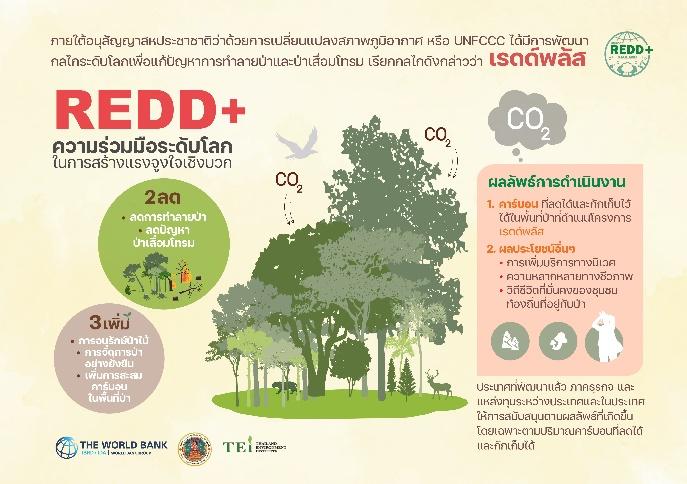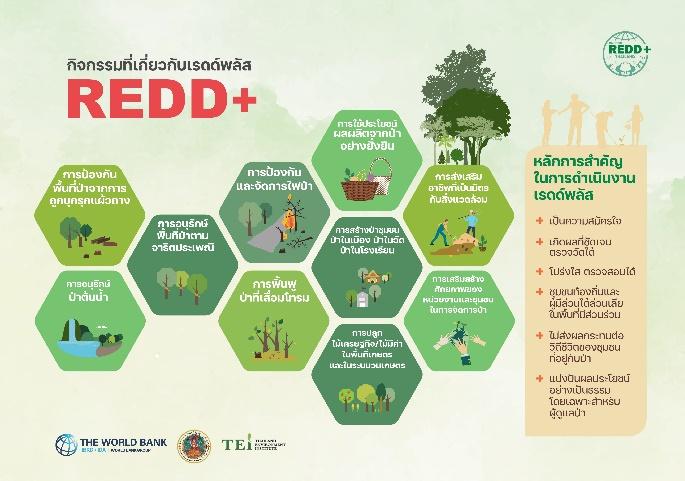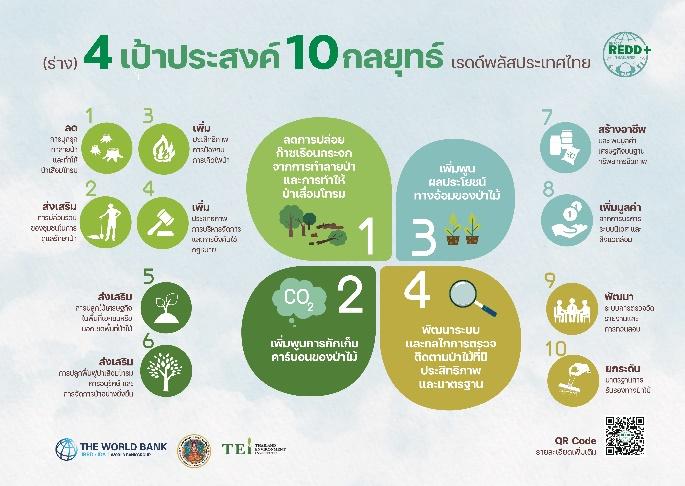1.1
Consistency with national policies, laws, strategies or plans related to the forest sector and support the progress of policies, laws, and plans.
1.2
Consistency and support to the implementations of relevant international conventions and agreements that Thailand has ratified and being enforced
Consistent with national forest programmes, national laws, and relevant international conventions and agreements
REDD+ and other forest-based climate policies, strategies, measures, and activities must be consistent with and support national policies and goals related to the forest sector as outlined in the country's master plan e.g., National Forest Policy and master plans on biodiversity, climate change, sustainable development. In addition, they have to be consistent with important laws, conventions and international agreements related to natural resources and the environment and social issues that Thailand has ratified and are being enforced.
Principle
Strategies and measures for REDD+ and other forest climate mitigation projects. In Thailand, it must comply with national policies and laws. and support national goals for the forest sector., as well as relevant international conventions and agreements.
According to the Draft National REDD+ Strategy (NRS) developed in 2021, stated the key principles in formulating national REDD+ strategy include:
The Draft NRS also stated the consideration of national strategies and master plans to determine national REDD+ strategies as the following;
The NRS’s goal set to achieve 40% of forest area by 2037 (B.E. 2580), inline with the target stated in the National Forest Policy B.E. 2562 (2019) and the 12th National Economic and Social Development Plan B.E. 2560-2564 (2017-2021), and contributes to the target in the National Strategy to achieve 55% of the forest and green area in the country by 2037.
The Draft National REDD+ Strategy for Thailand was formulated in 2021 aims to increase country’s forest area up to 40% by 2037, which will also contribute to Thailand’s Carbon Neutrality as well as Net-Zero Greenhouse Gas Emissions targets. The draft NRS consists of four goals; (1) Reduce greenhouse gas emissions from deforestation and forest degradation, (2) Increase carbon sequestration of forests, (3) Enhance benefits of the forest, (4) Enhance efficiency of monitoring system and forest standard certification and 10 strategies as the following:
| Goals | Strategies | Workplans |
|---|---|---|
| Reduce greenhouse gas emissions from deforestation and forest degradation | Strategy 1: Promote the process of community participation in forest conservation | - Develop communication system to provide information to communities through various channels - Strengthen community groups and networks - Promote participation of youth groups |
| Strategy 2: Reducing forest encroachment | - Improve boundaries of all types of forest land - Land-use and forest land zoning; with clear zone for economic forests - Prepare database and maps of all types of forest land tenure - Develop strategy with relevant sectors to prevent using of high conservation value areas for infrastructure development - Apply surveillance technology |
|
| Strategy 3: Enhance the efficiency of forest fire prevention and management | - Awareness raising with community - Promote role and capacity building of community to monitor and manage forest fire - Use technology to detect hot spots and determine the areas at risk of fire - Develop innovation on fire prevention and control with other agencies - Develop agricultural methods to substitute crops burning |
|
| Strategy 4: Enhance law enforcement and management | - Integrate the National Forest Policy with other related policies - Strengthening enforcing of the laws with illegal activities, and follow up after prosecution - Build capacity of law enforcement officials - Strengthen the existing cooperation mechanisms |
|
| Increase carbon sequestration of forests | Strategy 5: Promote economic tree planting in private and non-forest areas | - Promote the planting of economic forest in the form of agroforestry, integrated agriculture, or eco-cultural agricultural practice - Cooperate with civil society and community enterprises for comprehensive use - Improve laws and regulations - Develop monetary and fiscal mechanisms - Promote comprehensive research and development, and use of database and technology |
| Strategy 6: Promote forest restoration for conservation | - Determine clear target areas and implement restoration following academic principles - Promote and support community forest management - Promote research on restoration of degraded forests - Develop economic mechanisms to support appropriate restoration and conservation |
|
| Enhance benefits of the forest | Strategy 7: Create jobs and adding value for economic development based on biological resources | - Promote planting of diverse local trees for food security and enhancing environmental quality - Promote and support the community enterprise and industry for comprehensive use of forest products - Promote research to add value and strengthen capacity of bio-economy, and fair sharing of benefits - Research on threats to biodiversity and prevention methods |
| Strategy 8: Adding value to ecosystem services | - Promote and support the use of forest services e.g. eco-tourism as additional income for communities - Develop economic instruments and PES to support community’s management - Create a system for equitable and fair sharing of benefits from ecosystem services |
|
| Enhance efficiency of monitoring system and forest standard certification | Strategy 9: Develop forest monitoring system | - Establish task force to perform measurement, reporting and verification, and on safeguard monitoring - Develop accurate and reliable mechanisms with participation from community and other agencies - Build capacity of personnel on MRV at central, regional and local levels - Integrate MRV of forest resources and SIS |
| Strategy 10: Develop forest standard certification | - Establish a specific agency to be responsible for forest standard certification in Thailand - Develop tools and mechanisms for forest certification that are in line with international standards - Enhance personnel capacity to work as forest certification auditors - Enhance capacity of officers, farmers and entrepreneurs to be able to gain forest certification |



- Further information on how safeguard A is respected will be complied and monitored using the following indicators.
1.1.3 Summary of contribution of REDD+ or other forest-based climate mitigation programs results against the national targets and policies specified in the National Strategy, National Forest Policy, and other relevant national plans.
1.2.3 Summary of contribution of REDD+ or other forest-based climate mitigation programs results against targets/measures of Thailand designed to contribute to international conventions and agreements that Thailand has ratified and are enforcing.
1.1.1 National strategies of REDD+ and other forest-based climate mitigation programs are designed to be consistent with the country's key policies, laws, strategies or plans on forestry, biodiversity, climate change and sustainable development
1.1.2 Sub-national project proposals and implementation plans must specify consistency with the country's key policies, laws, national strategies or plan on forestry, biodiversity, climate change and sustainable development
1.1.3 Summary of contribution of REDD+ or other forest-based climate mitigation programs results against the national targets and policies specified in the National Strategy, National Forest Policy, and other relevant national plans.
1.2.1 National REDD+ Strategy or other forest-based climate mitigation programs are designed to be consistent with international conventions and agreements that Thailand has ratified and being enforced
1.2.2 Sub-national project proposals and implementation plans must specify consistency with international conventions and agreements that Thailand has ratified and being enforced
1.2.3 Summary of contribution of REDD+ or other forest-based climate mitigation programs results against targets/measures of Thailand designed to contribute to international conventions and agreements that Thailand has ratified and are enforcing.
1.1.1 National strategies of REDD+ and other forest-based climate mitigation programs are designed to be consistent with the country's key policies, laws, strategies or plans on forestry, biodiversity, climate change and sustainable development
1.1.2 Sub-national project proposals and implementation plans must specify consistency with the country's key policies, laws, national strategies or plan on forestry, biodiversity, climate change and sustainable development
1.1.3 Summary of contribution of REDD+ or other forest-based climate mitigation programs results against the national targets and policies specified in the National Strategy, National Forest Policy, and other relevant national plans.
1.2.1 National REDD+ Strategy or other forest-based climate mitigation programs are designed to be consistent with international conventions and agreements that Thailand has ratified and being enforced
1.2.2 Sub-national project proposals and implementation plans must specify consistency with international conventions and agreements that Thailand has ratified and being enforced
1.2.3 Summary of contribution of REDD+ or other forest-based climate mitigation programs results against targets/measures of Thailand designed to contribute to international conventions and agreements that Thailand has ratified and are enforcing.
